
There’s no denying it: the world of business is changing. In fact, it’s more volatile now than ever before.
This can be attributed to rapid technological advancements and an increasingly global marketplace.
As a result, most businesses have had to adapt their strategies to remain competitive in such an uncertain environment.
A key area of focus for many businesses has been communication skills.
Effective communication is more critical than ever in today’s fast-paced and competitive business environment.
Communication is the foundation of any successful business.
Communication is essential for all employees, regardless of role or department. After all, how efficiently a company communicates directly influences its performance and productivity.
In this article, we will try to master the art of effective communication.
Let us explore some of the latest communication skills, statistics, and trends so you can stay up-to-date with this crucial area for your business moving forward.
Key Highlights (Editor’s Pick)
- Communication skills were ranked as the most crucial skill employers seek in new hires, rated 4.56 on a 5-point scale.
- Approximately 93% of effective communication is nonverbal, while spoken words account for only 7%.
- About 93% of effective communication is silent. There are always concealed layers of facial expressions, postures, gestures, tone of voice, and underlying emotions.
- Effective communication improves productivity by 25% when employees feel more engaged with their work and connected with their colleagues.
- 68% of employees admit to wasting too much time on productivity due to ineffective communication.
- 40% of employees globally think their workplace lacks communication and teamwork.
- 68% of customers indicated that they are likely to choose businesses that offer convenient communications.
- Companies with improved communications offerings accomplished a 9.5% increase in customer satisfaction and 5% more growth.
- Millennials are the most digitally native generation, with 90.4% using at least one social network and 42% posting updates at least once a week.
- Video content continues to dominate as the latest digital communication trend.
What is The Importance Of Communication In Business?
You know communication is vital to success if you own or run a business.
Whether you’re communicating with your employees, customers, or suppliers, effective communication is essential to keeping your business running smoothly.
Communication is crucial for businesses of all sizes. It helps companies run smoothly and efficiently by keeping everyone on the same page.
Good communication can also help build strong working relationships, improve morale, and increase productivity.
There are many ways to communicate in the workplace, such as face-to-face meetings, conference calls, group emails, and instant messaging.
The best ways to communicate vary depending on the situation.
General Communication Skills Statistics
1. According to a National Association of Colleges and Employers report, communication skills were ranked as the most crucial skill employers seek in new hires. Communication skills were rated 4.56 on a 5-point scale. (source)
2. 57% of surveyed security professionals in the IT services industry listed communication skills as the top soft skill their company requires. (source)
3. In the U.K., over 1.7 million people were employed in the information and communication industry. (source)
4. The time spent on in-person interaction in business communication is around 23%. (source)
5. Approximately 93% of effective communication is nonverbal, while spoken words account for only 7%. (source)
6. Due to poor communication, 100,000 employees in the UK and U.S. lost $62.4 million annually. At the same time, companies with effective communication made 50% higher total returns. (source)
7. About 93% of effective communication is silent. There are always concealed layers of facial expressions, postures, gestures, tone of voice, and underlying emotions. (source)
8. The self-efficacy and performance of health professionals can be improved by training in communication skills. (source)
9. As of 2023, 32% of professionals claimed that effective communication with clients and coworkers has been challenging over the past 12 months. (source)
10. Being as specific as possible is needed in workplaces for effective communication. (source)
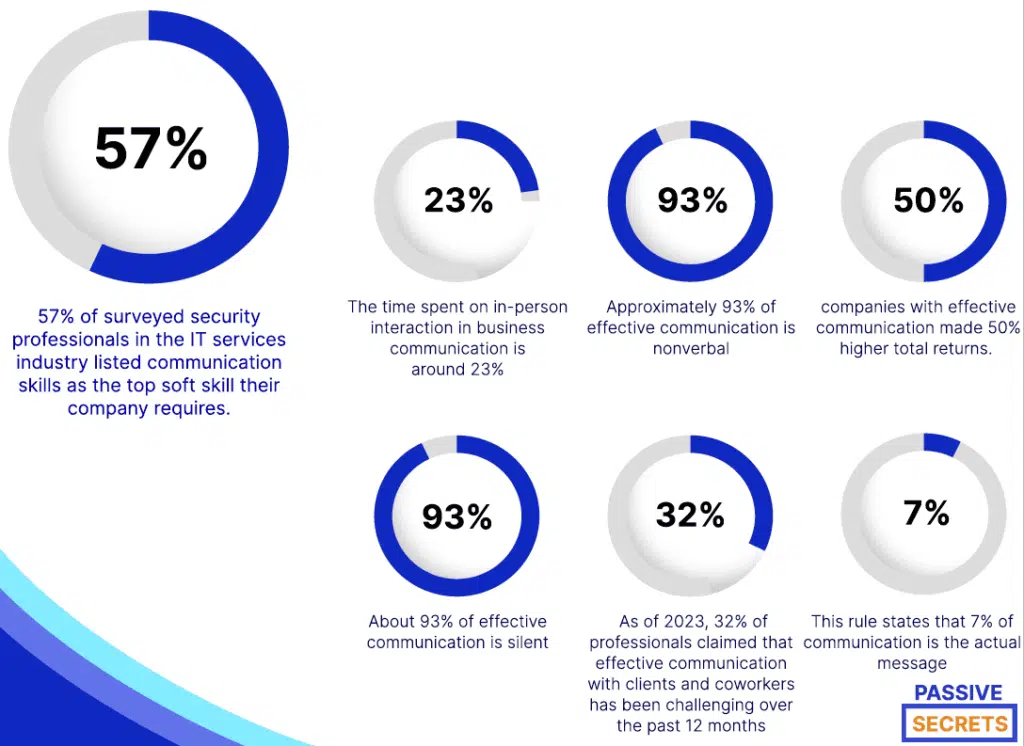
11. There is a 7-38-55 communication rule that highlights the importance of nonverbal communication. (source)
This rule states that 7% of communication is the actual message, while 38% emphasizes the tone of voice and 55% the body language.
Digital Communication Skills Statistics
12. About 54% of global respondents in a survey said that COVID-19 helped them increase their “focus on both omnichannel and multichannel digital communication” in their companies. (source)
Meanwhile, 53% say they included new channels for digital communications.
13. 76% of respondents surveyed in the U.S. stated that they used email or other messaging services to communicate with others. (source)
14. The global communications market generated up to $1.37 trillion in revenue in 2021. (source)
15. About 65.7% (approximately 5.3 billion) of the world’s population are Internet users, and 61.4% are on social media. (source)
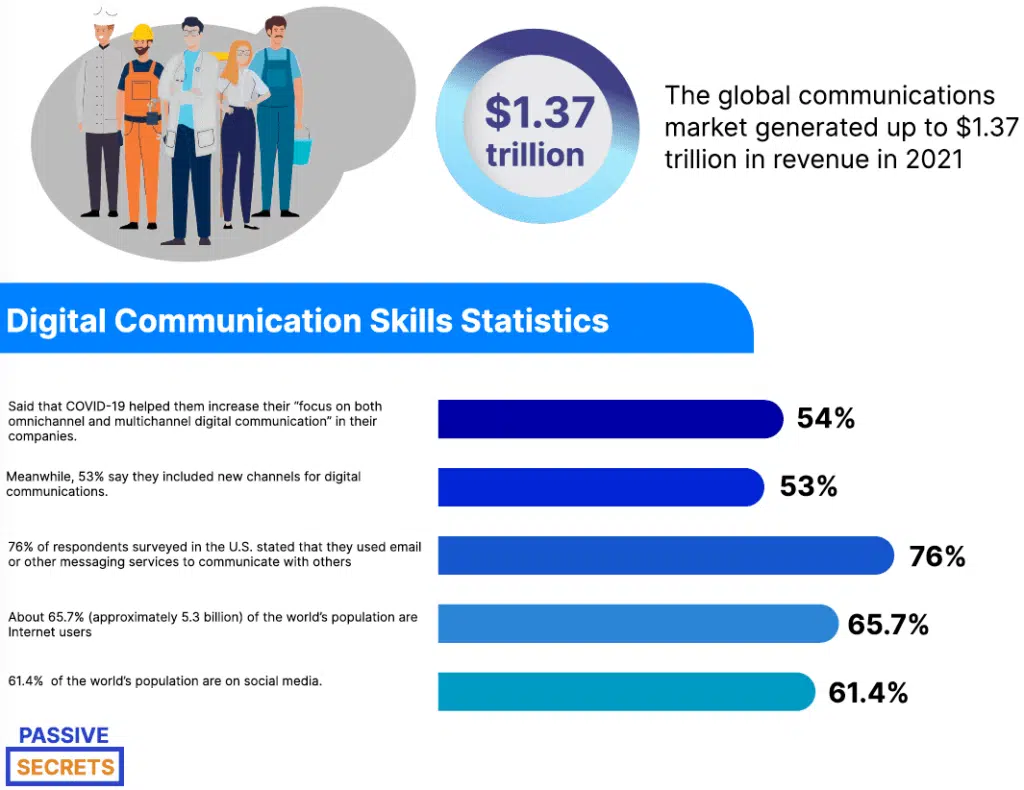
Employee Communication Statistics
Effective communication is the key to any successful relationship, whether it be personal or professional. It’s the glue that holds people together and allows them to understand each other.
A recent study found that effective communication facilitates trust between coworkers, leading to a more positive work environment and increased productivity.
Effective Communication Skills Increases Productivity
16. Effective communication improves productivity by 25% when employees feel more engaged with their work and connected with their colleagues. (source)
17. 68% of employees admit to wasting too much time on productivity due to ineffective communication. (source)
18. 40% of employees globally think their workplace lacks communication and teamwork. (source)
19. Research has shown that 72% of business leaders claim effective communication has increased the productivity of the work team. (source)
20. About 60% of 251 business managers claim that effective communication increases employees’ confidence at work. (source)
21. Effective communication affects employees’ productivity, engagement, retention, and trust. (source)
22. Employees who feel included in more detailed workplace communication, especially on remote jobs, are 5× more likely to report increased productivity. (source)
23. Employees who feel connected and well-informed in their workplaces are 71% more productive than employees who are not. (source)
This is because a high level of connection allows workers to be as efficient and creative as possible. It is also easier to thrive in an environment where one feels needed.
Effective Communication Skills Facilitate Trust
24. Companies that show clients that they understand them, know their needs, and want to help are always more successful. (source)
25. 83% of full-time employees said they trust their HR department. However, two-thirds of them say they haven’t reported a complaint to HR because they don’t think HR would fix the issue. (source)
26. According to Edelman’s “Trust Barometer,” one in three people don’t trust their employer. (source)
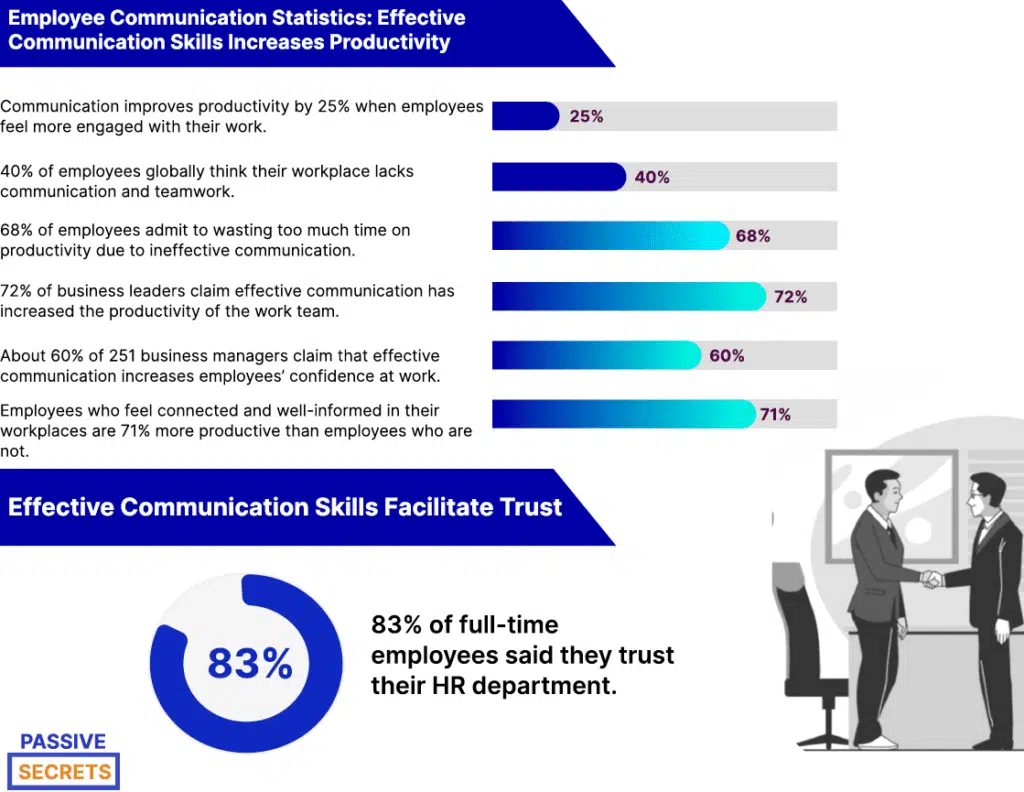
Effective Communication Skills Increases Retention
27. Employees who feel they can openly communicate with their managers will likely stay with the company. (source)
28. Effective communication also includes finding new ways to recognize employees. Employees are more likely to stay if their company recognizes their efforts. (source)
29. No one will be willing to work where they are not gaining experience, so offering benefits, development opportunities, and a conducive work environment helps employee retention. (source)
The Cost of Poor Communication Skills
30. It has been reported that employees feel frustrated and stressed due to a lack of proper communication, leading to low productivity and efficiency. (source)
31. Research has shown that the lack of engagement among employees worldwide has cost a whopping $8.8 trillion. (source)
32. Poor business communication has led to 68% wasted time, 53% missed messages, 42% burnout, stress, and fatigue, 35% lost files, 30% bad customer experience, 12% lost customers to competitors, and 10% lost employers. (source)
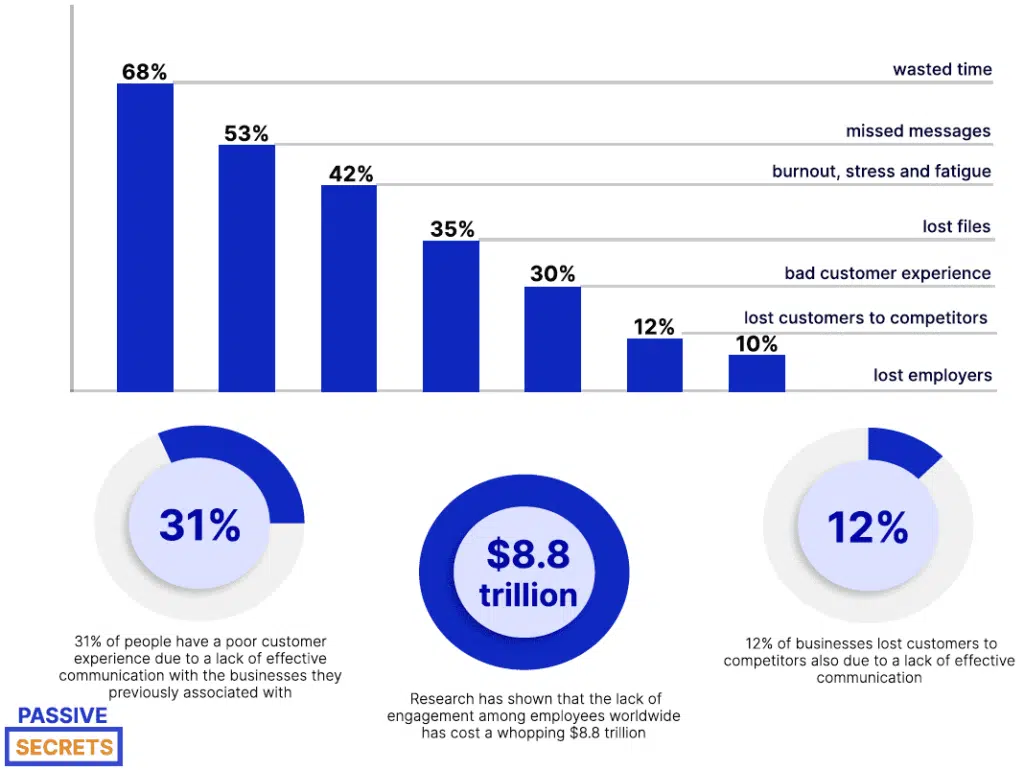
33. 31% of people have a poor customer experience due to a lack of effective communication with the businesses they previously associated with. (source)
34. 12% of businesses lost customers to competitors also due to a lack of effective communication. (source)
Corporate Communication Statistics
It’s no secret that communication is key to a successful business.
Good communication can lead to a better understanding amongst employees, help avoid or resolve conflict, and increase productivity.
Conversely, poor communication can result in a lack of clarity and direction, decreased morale, and reduced productivity.
Here are some exciting communication skill statistics and facts regarding corporations:
35. Gallup’s survey shows that employees with a best friend at work are likely to be seven times engaged. (source)
36. A company that communicates with innovation, courage, and discipline, especially during economic challenges and change, is more effective at engaging employees and achieving desired business results. (source)
37. A study by Gallup shows that if a team is highly engaged, its profitability increases by 23%. (source)
38. 65% of the U.S. workforce say they are not engaged in their workplace. (source)
39. Only 21% of employees are engaged at work. Employee disengagement causes poor workplace communication and vice versa. (source)
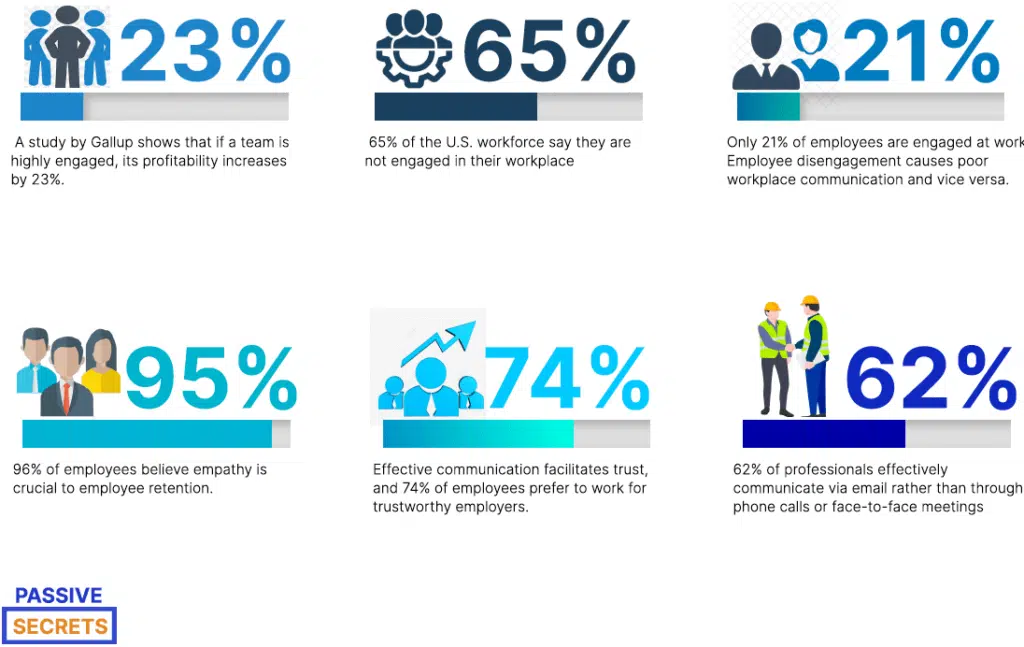
40. 96% of employees believe empathy is crucial to employee retention. (source)
41. Employees who feel their voices are heard are 4.6x more likely to increase productivity. (source)
42. Effective communication facilitates trust, and 74% of employees prefer to work for trustworthy employers. (source)
43. 62% of professionals effectively communicate via email rather than through phone calls or face-to-face meetings. (source)
44. Communication is vital when understanding employees’ feelings. For example, employees who receive positive feedback “are 3.9x more likely to be engaged than employees who felt hurt. (source)
Lack of communication is one of the reasons why employees are unsatisfied with their jobs.
Marketing Communications Statistics
Marketing communications is a broad field that covers many different aspects of marketing and advertising.
While having a well-rounded marketing communications strategy is essential, knowing which tactics are most effective is important.
If you’re working in the industry and want to stay up to date, here are some statistics;
45. 68% of customers indicated that if they can choose where to purchase, they will likely go with the business that offers convenient communications. (source)
46. Companies with more improved communications offerings accomplished better results, which included a 9.5% increase in customer satisfaction and 5% more growth. (source)
Latest Communication Trends
Millennials are the most digitally native generation, with 90.4% using at least one social network and 42% posting updates at least once a week. These numbers illustrate how important digital communication has become for millennials.
Understanding the latest trends in millennial communication is essential for any business or organization targeting this audience.
With so many options available, there’s no single way that millennials prefer to communicate.
However, there are some differences between older millennials (those born between 1981 and 1996) and Generation Z (born after 1996).
Each group has different values and habits when it comes to communicating, which necessitates an updated strategy when marketing to them.
Here are some of the latest trends in communication that you should know about if you work in HR or communications or have friends in those fields.
Digital Communications Trends
Digital communications are becoming increasingly important in our personal and professional lives. Here are some digital communication trends to watch for;
1. Video Content
The use of video for marketing, advertising, and communication has exploded in recent years. And there’s no sign of it slowing down anytime soon. In fact, video content continues to dominate as the latest digital communication trends.
There are several reasons for this increase in popularity.
For one, videos are incredibly engaging and capture our attention much more quickly than text or images alone.
They’re also easy to share across social media and other channels, making them an ideal way to reach a broad audience quickly.
Moreover, thanks to technological advances, creating high-quality video content is more affordable and accessible than ever.
And with the rise of platforms like YouTube and Instagram TV, it’s easier than ever to get your videos seen by millions of people around the world.
2. Augmented And Virtual Reality
With the COVID-19 pandemic continuing to impact how we live and work, we’ll likely see more use of augmented and virtual reality in the near future. Here are some of the ways this technology is being used today:
- Entertainment: Gaming is among the most popular augmented and virtual reality used. Games such as Pokémon GO, Minecraft Earth, and The Walking Dead: Our World use AR to bring players into an immersive experience.
- Education: AR and VR are being used to create immersive learning experiences. Students can take virtual field trips, explore 3D models of molecules or cells, or experience historical events firsthand.
- Training: AR and VR can provide realistic simulations for training purposes. For example, surgeons can use VR to practice operations before performing them on actual patients. Likewise, pilots can use an AR headset to view information while flying a plane.
3. Voice Search
Voice search is an emerging trend in the digital communication industry. It is a natural communication and the easiest way to find information.
As the world becomes increasingly mobile and voice-activated, you can expect voice search to become even more important as a primary way consumers interact with brands.
Voice search differs from other search forms as it requires a more personal, one-on-one relationship between the person making the search query and the brand they ultimately land on.
4. AI and Machine Learning
How we communicate is changing, and it’s happening faster than ever. Just think about how quickly social media platforms have become commonplace in our day-to-day lives.
Or how we now rely on messaging apps to stay in touch with family and friends. Digital communication is evolving at a rapid pace, and new technologies are emerging all the time.
Artificial intelligence (AI) is revolutionizing the way we communicate. Machines are starting to understand and respond to human emotions, and this technology will only become more sophisticated.
This trend is particularly evident in the customer service industry, where AI-powered chatbots are increasingly used to handle simple queries.
In the future, AI could even be used to generate personalized content for individual users.
Machine learning is also playing a significant role in digital marketing.
For example, this technology can be used to target ads more effectively, and it’s also being used to create dynamic, real-time content.
5. Live Streaming
Live streaming is an ever-evolving digital communication and marketing trend in 2024.
It has an interactive and engaging way of communicating, as viewers can chat with the streamer in real-time and even make purchases or any other form of commitment.
It provides an affordable and accessible way of reaching a broad audience and building a lasting community simultaneously.
Live streaming also helps to create a sense of immediacy and transparency, as the content is happening instantly. This means it cannot be edited or manipulated.
6. Integration of Automation and Artificial Intelligence(AI)
The use of automation and AI tools simultaneously in digital communication is becoming increasingly popular, as it has several benefits.
They both allow more efficient communication, as messages can be automated and sent at specific times or in response to certain events.
These messages can also be personalized due to the ability of AI-powered tools to analyze data and then tailor messages to individual users.
It can help to scale communication. This is because AI tools can handle large amounts of messages that would be difficult for humans to manage and improve customer service.
Automation and AI tools can also help reduce costs, as it sometimes eliminates the need for human resources.
They also help to improve accessibility and can be used to translate messages into different languages and provide accessible formats for other users.
Employee Communication Trends
The employee experience is constantly changing. Therefore, you must stay on top of these changes to support your employees effectively.
To do so, you’ll need to know what communication trends are coming up in 2024 and beyond.
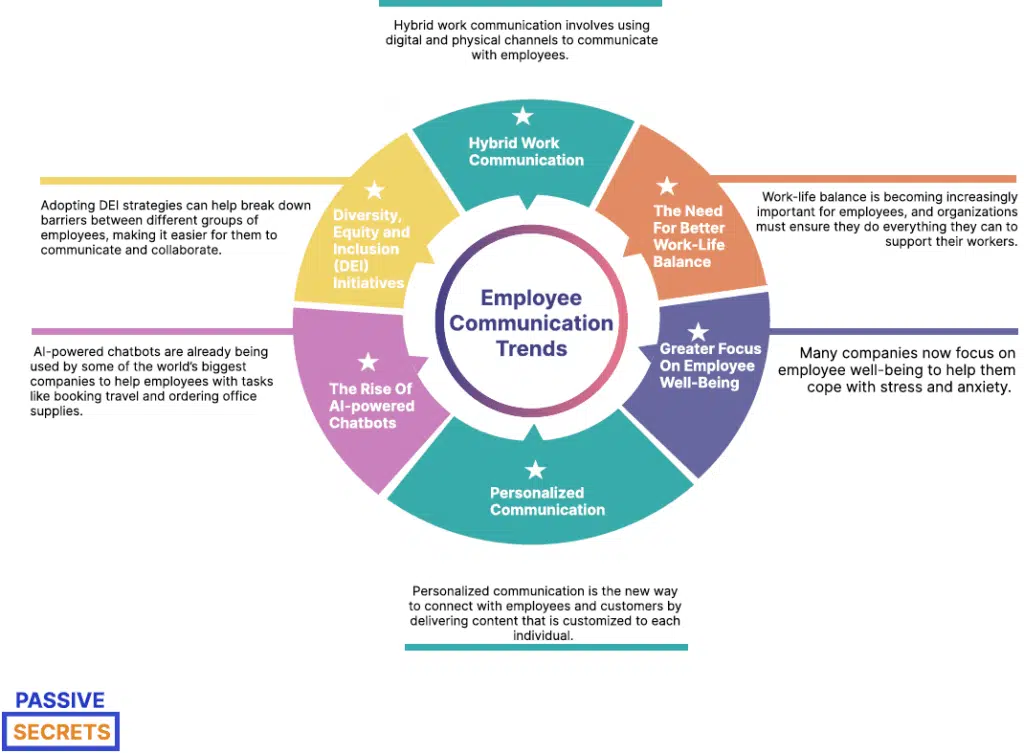
1. Hybrid Work Communication
Due to the COVID-19 pandemic, many companies now allow employees to work from home.
Hybrid work communication involves using digital and physical channels to communicate with employees.
This includes email, instant messaging, video conferencing, and even face-to-face meetings.
Hybrid work communication allows employees to work from anywhere while staying connected with their colleagues. Some of the benefits of hybrid work communication include the following:
Improved employee productivity: When employees can work from home, they can eliminate distractions and better focus on their work. This can lead to increased productivity.
Increased employee satisfaction: Employees who can work from home are often more satisfied with their jobs. This can lead to increased retention rates.
2. The Need For Better Work-Life Balance
The COVID-19 pandemic has forced many organizations to re-evaluate their policies and procedures, especially regarding employee communication.
In the wake of the pandemic, there is much need for better work-life balance.
The pandemic has highlighted the importance of work-life balance for employees.
As a result, many workers now have to work from home, which can be both a blessing and a curse. Organizations must find ways to support their employees’ work-life balance needs.
Some ways to do this include offering flexible working arrangements, providing access to mental health resources, and encouraging employees to take time off when needed.
Work-life balance is becoming increasingly important for employees, and organizations must ensure they do everything they can to support their workers.
3. Greater Focus On Employee Well-Being
The focus on employees’ well-being is among the latest employee communication trends because of the pandemic. The pandemic has caused a lot of stress and anxiety for employees.
Many companies now focus on employee well-being to help them cope with stress and anxiety.
Some of the ways that companies are focus on employee well-being include:
- Offering mental health benefits
- Providing access to mental health resources
- Encouraging employees to take breaks
- Promoting a healthy work-life balance
4. Personalized Communication
Personalized communication is the new way to connect with employees and customers by delivering content that is customized to each individual.
It is a form of communication tailored to each recipient’s needs rather than sending a one-size-fits-all message to an entire group.
Personalized communication can be delivered via email, SMS, or social media platforms like Facebook and Instagram.
The main aim of personalized communication is to drive engagement, loyalty, and referrals by improving the experience that recipients have when communicating with your company.
There are various benefits to using personalized communication, such as:
- improving response rates,
- driving referrals,
- improving engagement, and
- generating more business ideas.
5. The Rise Of AI-powered Chatbots
There’s no question that artificial intelligence (AI) is rapidly changing how we work. And, as AI continues to evolve, so does its potential to transform employee communications.
In fact, AI-powered chatbots are already being used by some of the world’s biggest companies to help employees with tasks like booking travel and ordering office supplies.
Chatbots can automate basic customer service tasks, such as answering questions about products and services and gathering customer feedback.
A chatbot can be programmed to communicate with employees in real-time.
For example, a company’s communication software can be programmed to send a message to an employee when a certain sale ends or a particular product is out of stock.
It can also be programmed to conduct training and onboarding for new employees by asking questions and providing feedback. Thus, enterprises can reduce the cost of hiring employees for training and onboarding.
6. Diversity, Equity and Inclusion (DEI) Initiatives
DEI initiatives are programs and policies designed to promote diversity, equity, and inclusion within an organization.
Diversity refers to having a workforce representative of the population at large in terms of age, gender, race, etc.
Equity refers to ensuring all employees have equal access to the same opportunities and resources.
Inclusion refers to creating an environment where all employees feel valued, respected, and heard.
Organizations can create a more inclusive and productive workplace by implementing DEI policies.
This would also encourage employees to feel comfortable sharing their thoughts and ideas.
Adopting DEI strategies can help break down barriers between different groups of employees, making it easier for them to communicate and collaborate.
Finally, DEI initiatives can help create a sense of unity among employees and ensure everyone is on the same page.
Marketing Communications Trends
The landscape of marketing communications is constantly evolving. As we move further into the 2020s, we expect to see several new trends that will change how brands communicate with their audiences.
Here are a few predictions for marketing communication trends:
1. Growth and Improvement of Conversational AI
Conversational AI has been one of the most talked about topics in marketing and communications for the past few years.
As technology continues to evolve, so does how brands use it to interact with their audiences.
In 2019, several brands experiment with chatbots and voice assistants to improve customer service, drive sales, and even create new user experiences.
Here are some of the most notable examples:
- Sephora used chatbots to help customers find products and schedule appointments.
- Starbucks created a voice-activated ordering system for its mobile app.
- Dominos created a chatbot allowing customers to order pizza by text or voice.
- Taco Bell launched a bot enabling users to order and pay for their food without ever leaving Messenger.
2. Personalization
Personalization has been a marketing buzzword for a few years now, but it’s no longer a “nice to have.”
Instead, it’s become a “need to have.”
A study found that 91% of consumers are more likely to buy from a retailer or brand that recognizes them by name, recommends options based on past purchases, or knows their purchase history.
It doesn’t just end with retail. Personalization is vital across all industries, from banking and insurance to healthcare and B2B. So how can you personalize your marketing communications?
Use data to segment your audience. The first step is to use the data you have about your customers and prospects to segment them into groups with similar characteristics.
This could be based on demographics, location, behavior, or engagement with your brand. Once you have your segments, you can develop personalized messages for each.
3. Adaptation to a Cookie-less World
With the rise of ad blockers and privacy-conscious browsers, cookies are declining. This is a big problem for marketers, who have relied on cookies for years to track user behavior and deliver targeted ads.
So what can marketers do to adapt to a cookie-less world?
- Use First-party Data: First-party data is data you collect through surveys or sign-ups. This data can create buyer personas and target your marketing efforts.
- Use Alternative Tracking Methods: A few alternative tracking methods, such as fingerprinting and server-side tracking, don’t rely on cookies. These methods are more complex, but they may be necessary in a cookie-less world.
- Focus on Other Channels: If you can’t track users online, focus on other marketing channels where you can reach your audiences, such as offline advertising or PR.
4. Augmented Reality And Virtual Reality
Undoubtedly, Augmented Reality (AR) and Virtual Reality (VR) technology are becoming increasingly sophisticated. In fact, it’s estimated that the global AR and VR market was worth $209.2 billion in 2022.
So, what does this mean for marketing communications? As technology continues to develop, so will how we can use it to engage with our audiences.
We already see some brands using AR and VR in innovative and exciting ways, and we can only expect this to continue in the future.
Some examples of brands using AR and VR include Ikea’s Place app, which lets you see how furniture would look in your home before you buy it.
Sephora’s Virtual Artist app lets you try makeup virtually before buying it.
PepsiCo’s Doritos Blaze app lets you play a game in augmented reality. And Walmart is using virtual reality to train its employees.
5. More Omnichannel Strategies
Omnichannel marketing is quickly becoming one of the hottest topics in the industry. As consumers move between channels, their expectations for a seamless experience increase.
Omnichannel marketing statistics show that more companies and marketers, including B2B marketers, are diving into more omnichannel marketing strategies.
This means that businesses need to be able to meet them where they are and provide a consistent message across all touchpoints.
While this may seem daunting, you can implement key strategies to ensure your omnichannel strategy succeeds.
Define Your Channels
This will vary depending on your business and goals, but some standard options include email, social media, SMS, push notifications, and in-app messaging.
Once you’ve identified which channels you want to use, you can start thinking about utilizing each one best.
Create Consistent Messaging
One of the most critical aspects of an omnichannel strategy is ensuring that your messaging is consistent across all channels.
This means using the same tone and language throughout your communications.
It’s also essential to ensure that your call-to-action (CTA) is clear and consistent so customers know what they need.
6. Influencer Marketing
Influencer marketing is a type of marketing that relies on endorsements and recommendations from individuals who have a large social media following.
This trend is becoming increasingly popular as more people turn to social media for information and inspiration.
Influencer marketing can be a very effective way to reach a broad audience and build trust with potential customers.
For example, a tech company might work with a famous Instagram influencer to promote their products or services. They might collaborate with a renowned blogger to create content about their brand.
There are many reasons why influencer marketing is so effective. First, it relies on the power of word-of-mouth marketing, one of the most powerful forms of marketing.
It also enables companies to tap into the trust and credibility that influencers have built with their followers over time.
FAQS About Communication Skills
1. What are Some Effective Communication Skills in Business?
- Collaboration and teamwork: They are vital to business success
- Public Speaking
- Listening
- Nonverbal Communication
- Written Communication
2. What are the 6 Communication Skills?
- Active listening
- Responsiveness
- Understanding different communication styles
- Empathy
- Body language and non-verbal cues
- Writing skills
3. What is the Importance of Communication Skills?
Communication skills are essential in all aspects of life. Communicating effectively can help you succeed in your career, build strong relationships, and resolve conflicts.
Good communication involves more than just speaking or writing clearly. It also requires listening skills, nonverbal communication, and understanding and sharing information.
Conclusion
When it comes to the workplace, communication is everything. It’s the oxygen that keeps the engine of business running smoothly.
A positive culture is one of the best ways to communicate effectively. The right environment makes people feel like they are part of a close-knit team and encourages them to deliver their best daily.
Also, effective communication is vital in forming and maintaining strong relationships with others. It can help improve morale and provide growth opportunities.
There is a lot to be said about developing communication skills. Investing in this area not only promotes business growth but can also have other benefits.
Although we can’t predict the future, you can prepare for the future by better understanding statistics and trends in communication skills.

Related Post:
- Incredible Women in Leadership Statistics: Insights into Global Gender Representation
- Billionaire Statistics: Surprising Insights About The World’s Wealthiest
- 89 Business Loan Statistics Every Entrepreneur Should Know
- 70+ AI in Education Statistics That Prove the Future Is Already Here
- Soft Skills Statistics: Key Data on Demand, Training, and Impact
- 95+ Fascinating Gift Industry Statistics to Surprise and Delight
- Top Business Coaching Statistics & Trends Every Leader Should Know
- How Much Are People Saving? Key Personal Savings Statistics Explained
- 40+ Useful Procrastination Statistics To Help You
- 90 Amazing Millionaire Statistics & Facts You Dare Not Miss
- 50+ Latest Life Coaching Statistics And Huge Trends
- 30+ Useful Real Estate Photography Statistics and Trends You Need to Know
- Data-Driven Decision-Making Statistics: Trends, Benefits & Challenges
- 54 Incredible Goal-Setting Statistics To Help You
- Body Language Statistics & Fun Facts To Boost Your Communication Skills
- 35 Interesting Public Speaking Fear Statistics & Fun Facts
- 25+ Most Interesting Emotional Intelligence Statistics & Fun Facts

